BMP6002 - Strategic Planning: River Island's Business Strategy Review
VerifiedAdded on 2023/06/11
|13
|2714
|349
Report
AI Summary
This report provides a comprehensive analysis of strategic planning processes, focusing on River Island as a case study. It begins by defining strategic management and detailing the processes organizations use to determine their strategies, including initial assessment, situational analysis, strategy formulation, implementation, and monitoring. The report critically evaluates the impact of internal and external environmental factors on River Island's strategy, utilizing SWOT and PESTLE analyses to assess the company's strengths, weaknesses, opportunities, and threats, as well as the political, economic, social, technological, legal, and environmental forces affecting its operations. The report concludes with a review of River Island's strategic plan, included as an appendix, and proposes an action plan based on potential changes in the internal or external environment. The analysis covers areas such as innovation, pricing, seasonal changes, economic shifts, foreign market expansion, online positioning, price wars, and government policy changes, providing a thorough evaluation of River Island's strategic position and potential future directions.
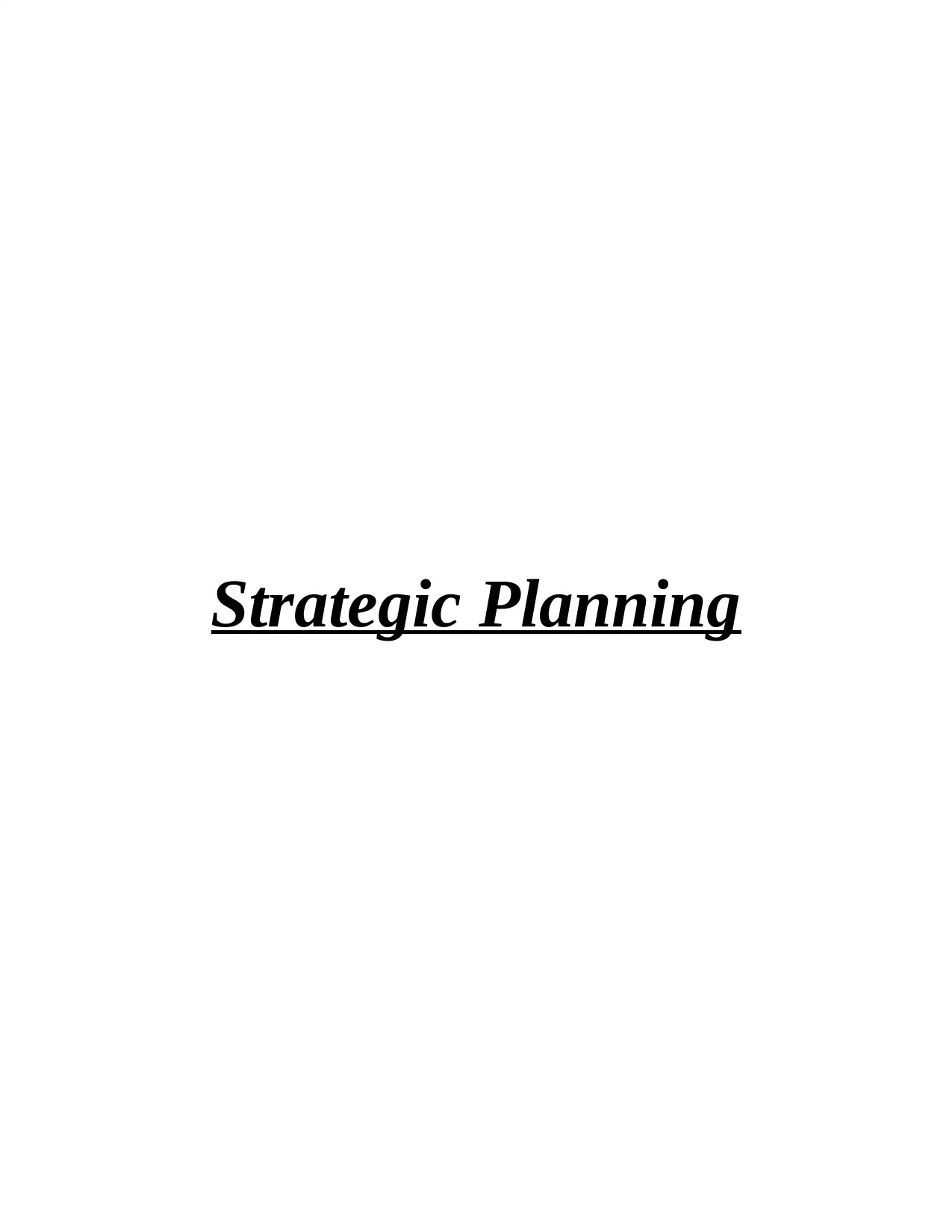
Strategic Planning
Paraphrase This Document
Need a fresh take? Get an instant paraphrase of this document with our AI Paraphraser
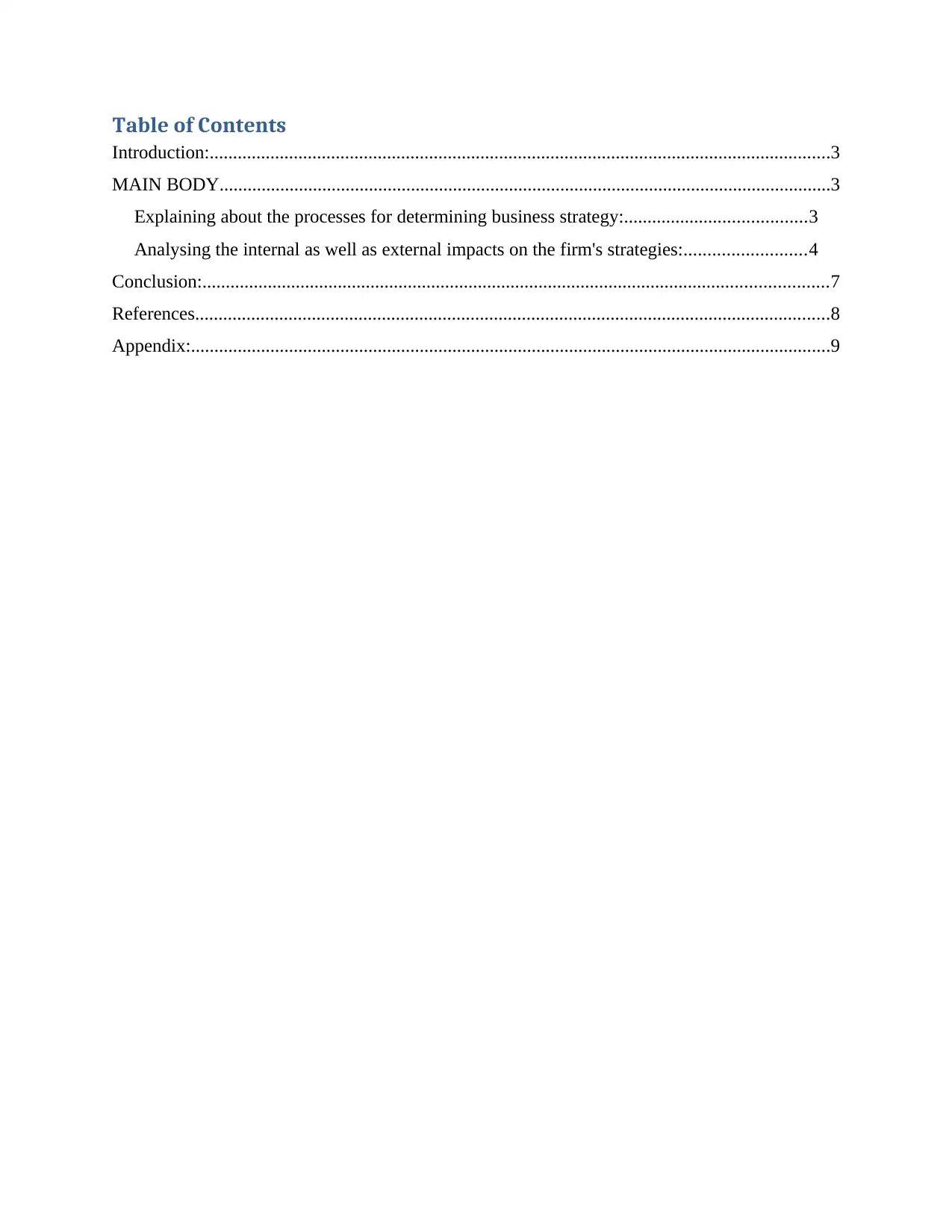
Table of Contents
Introduction:.....................................................................................................................................3
MAIN BODY...................................................................................................................................3
Explaining about the processes for determining business strategy:.......................................3
Analysing the internal as well as external impacts on the firm's strategies:..........................4
Conclusion:......................................................................................................................................7
References........................................................................................................................................8
Appendix:.........................................................................................................................................9
Introduction:.....................................................................................................................................3
MAIN BODY...................................................................................................................................3
Explaining about the processes for determining business strategy:.......................................3
Analysing the internal as well as external impacts on the firm's strategies:..........................4
Conclusion:......................................................................................................................................7
References........................................................................................................................................8
Appendix:.........................................................................................................................................9
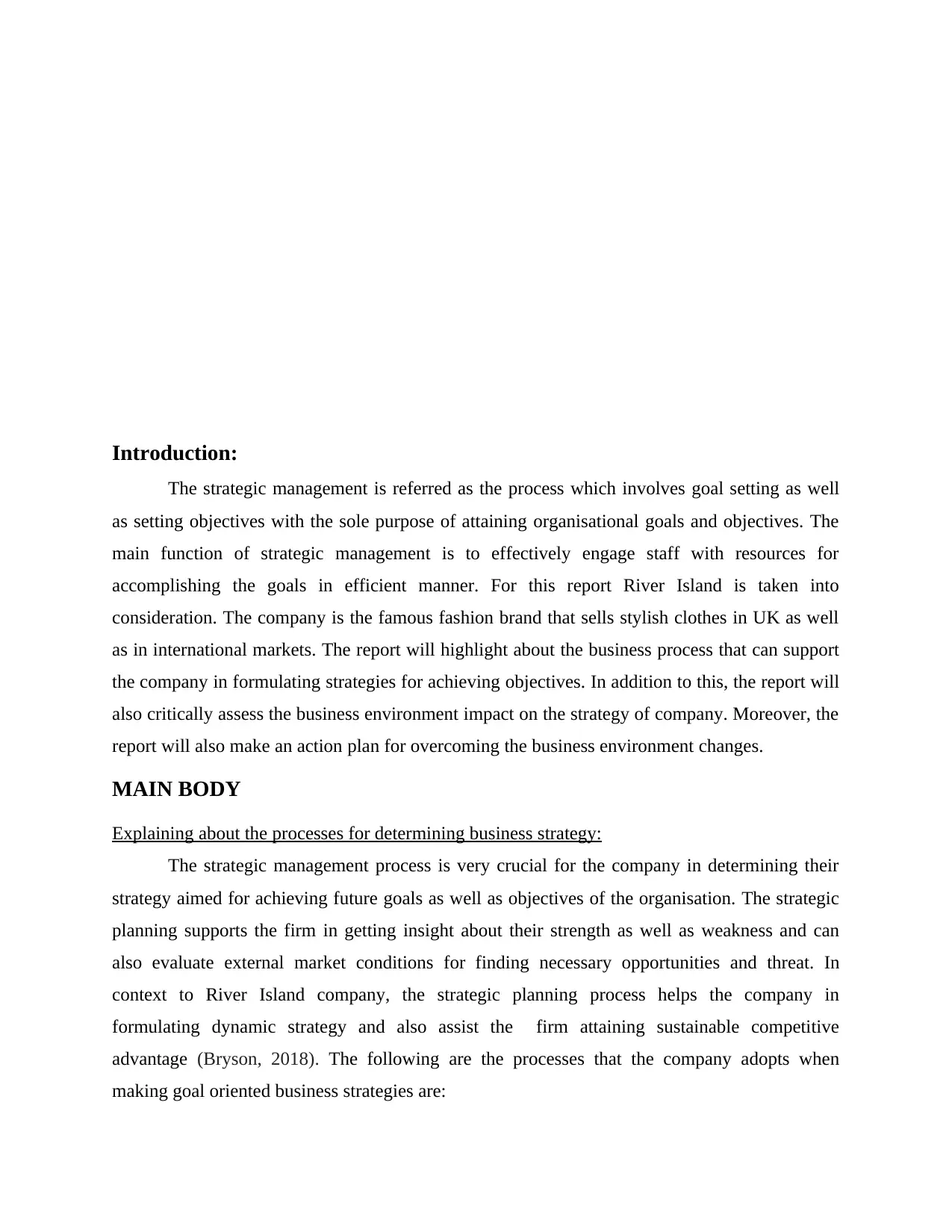
Introduction:
The strategic management is referred as the process which involves goal setting as well
as setting objectives with the sole purpose of attaining organisational goals and objectives. The
main function of strategic management is to effectively engage staff with resources for
accomplishing the goals in efficient manner. For this report River Island is taken into
consideration. The company is the famous fashion brand that sells stylish clothes in UK as well
as in international markets. The report will highlight about the business process that can support
the company in formulating strategies for achieving objectives. In addition to this, the report will
also critically assess the business environment impact on the strategy of company. Moreover, the
report will also make an action plan for overcoming the business environment changes.
MAIN BODY
Explaining about the processes for determining business strategy:
The strategic management process is very crucial for the company in determining their
strategy aimed for achieving future goals as well as objectives of the organisation. The strategic
planning supports the firm in getting insight about their strength as well as weakness and can
also evaluate external market conditions for finding necessary opportunities and threat. In
context to River Island company, the strategic planning process helps the company in
formulating dynamic strategy and also assist the firm attaining sustainable competitive
advantage (Bryson, 2018). The following are the processes that the company adopts when
making goal oriented business strategies are:
The strategic management is referred as the process which involves goal setting as well
as setting objectives with the sole purpose of attaining organisational goals and objectives. The
main function of strategic management is to effectively engage staff with resources for
accomplishing the goals in efficient manner. For this report River Island is taken into
consideration. The company is the famous fashion brand that sells stylish clothes in UK as well
as in international markets. The report will highlight about the business process that can support
the company in formulating strategies for achieving objectives. In addition to this, the report will
also critically assess the business environment impact on the strategy of company. Moreover, the
report will also make an action plan for overcoming the business environment changes.
MAIN BODY
Explaining about the processes for determining business strategy:
The strategic management process is very crucial for the company in determining their
strategy aimed for achieving future goals as well as objectives of the organisation. The strategic
planning supports the firm in getting insight about their strength as well as weakness and can
also evaluate external market conditions for finding necessary opportunities and threat. In
context to River Island company, the strategic planning process helps the company in
formulating dynamic strategy and also assist the firm attaining sustainable competitive
advantage (Bryson, 2018). The following are the processes that the company adopts when
making goal oriented business strategies are:
⊘ This is a preview!⊘
Do you want full access?
Subscribe today to unlock all pages.

Trusted by 1+ million students worldwide
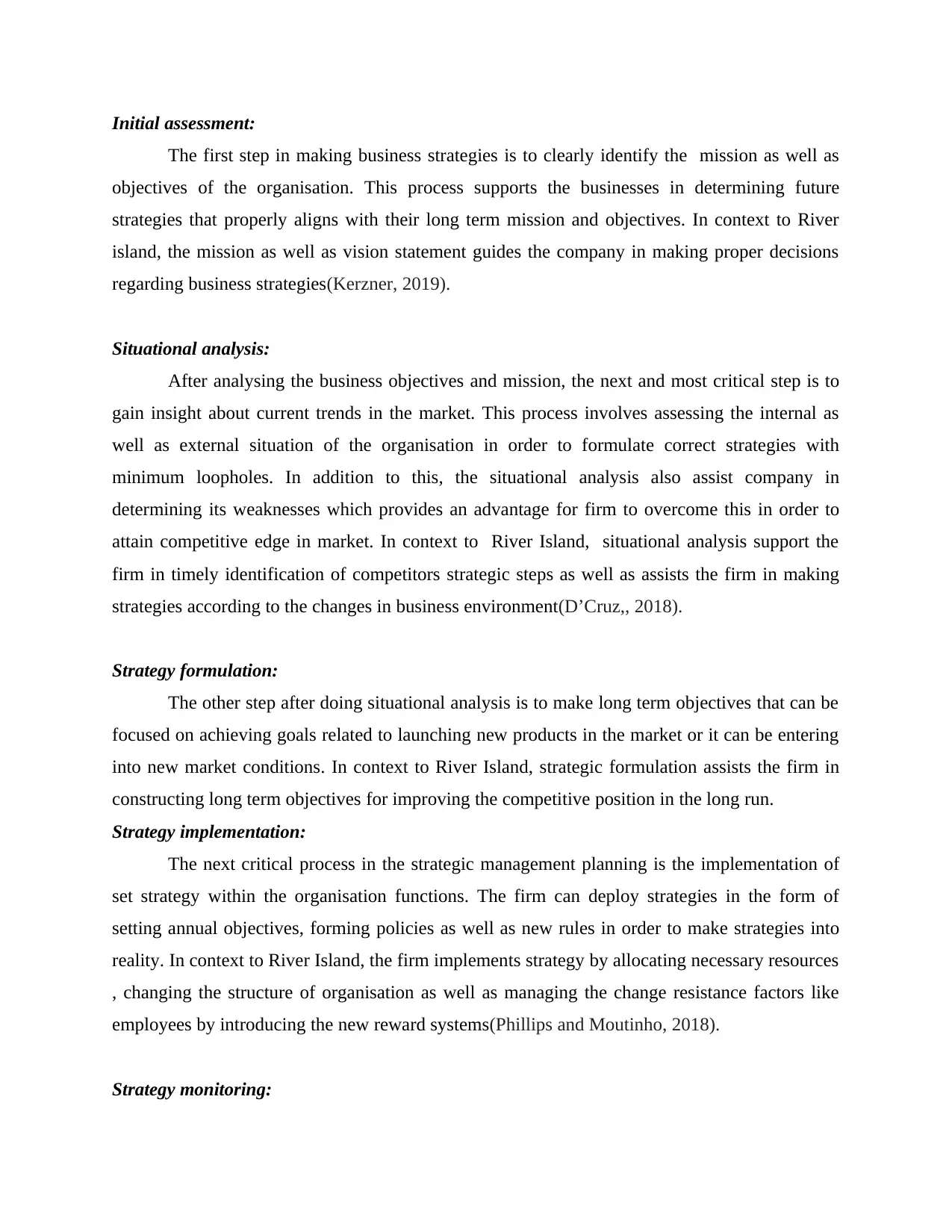
Initial assessment:
The first step in making business strategies is to clearly identify the mission as well as
objectives of the organisation. This process supports the businesses in determining future
strategies that properly aligns with their long term mission and objectives. In context to River
island, the mission as well as vision statement guides the company in making proper decisions
regarding business strategies(Kerzner, 2019).
Situational analysis:
After analysing the business objectives and mission, the next and most critical step is to
gain insight about current trends in the market. This process involves assessing the internal as
well as external situation of the organisation in order to formulate correct strategies with
minimum loopholes. In addition to this, the situational analysis also assist company in
determining its weaknesses which provides an advantage for firm to overcome this in order to
attain competitive edge in market. In context to River Island, situational analysis support the
firm in timely identification of competitors strategic steps as well as assists the firm in making
strategies according to the changes in business environment(D’Cruz,, 2018).
Strategy formulation:
The other step after doing situational analysis is to make long term objectives that can be
focused on achieving goals related to launching new products in the market or it can be entering
into new market conditions. In context to River Island, strategic formulation assists the firm in
constructing long term objectives for improving the competitive position in the long run.
Strategy implementation:
The next critical process in the strategic management planning is the implementation of
set strategy within the organisation functions. The firm can deploy strategies in the form of
setting annual objectives, forming policies as well as new rules in order to make strategies into
reality. In context to River Island, the firm implements strategy by allocating necessary resources
, changing the structure of organisation as well as managing the change resistance factors like
employees by introducing the new reward systems(Phillips and Moutinho, 2018).
Strategy monitoring:
The first step in making business strategies is to clearly identify the mission as well as
objectives of the organisation. This process supports the businesses in determining future
strategies that properly aligns with their long term mission and objectives. In context to River
island, the mission as well as vision statement guides the company in making proper decisions
regarding business strategies(Kerzner, 2019).
Situational analysis:
After analysing the business objectives and mission, the next and most critical step is to
gain insight about current trends in the market. This process involves assessing the internal as
well as external situation of the organisation in order to formulate correct strategies with
minimum loopholes. In addition to this, the situational analysis also assist company in
determining its weaknesses which provides an advantage for firm to overcome this in order to
attain competitive edge in market. In context to River Island, situational analysis support the
firm in timely identification of competitors strategic steps as well as assists the firm in making
strategies according to the changes in business environment(D’Cruz,, 2018).
Strategy formulation:
The other step after doing situational analysis is to make long term objectives that can be
focused on achieving goals related to launching new products in the market or it can be entering
into new market conditions. In context to River Island, strategic formulation assists the firm in
constructing long term objectives for improving the competitive position in the long run.
Strategy implementation:
The next critical process in the strategic management planning is the implementation of
set strategy within the organisation functions. The firm can deploy strategies in the form of
setting annual objectives, forming policies as well as new rules in order to make strategies into
reality. In context to River Island, the firm implements strategy by allocating necessary resources
, changing the structure of organisation as well as managing the change resistance factors like
employees by introducing the new reward systems(Phillips and Moutinho, 2018).
Strategy monitoring:
Paraphrase This Document
Need a fresh take? Get an instant paraphrase of this document with our AI Paraphraser
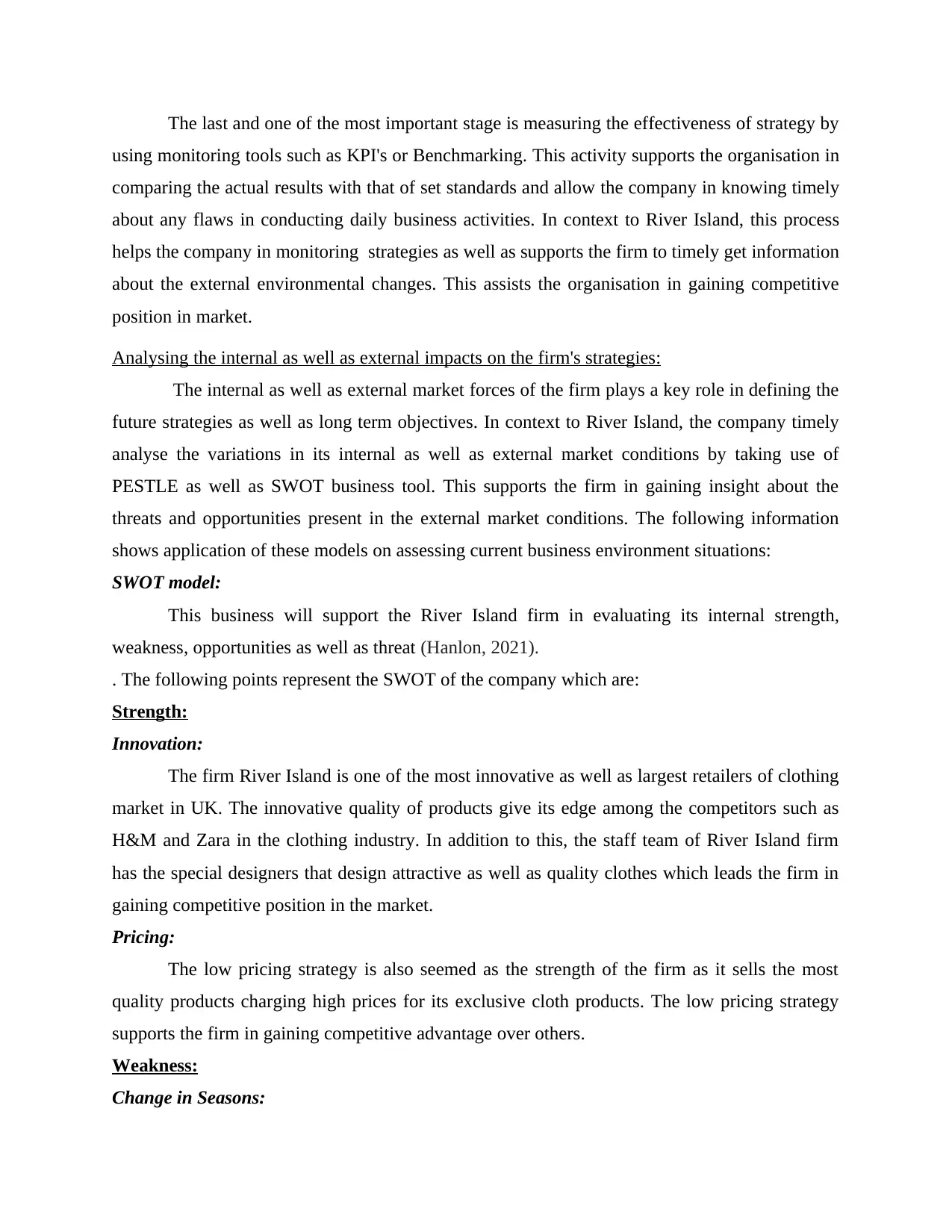
The last and one of the most important stage is measuring the effectiveness of strategy by
using monitoring tools such as KPI's or Benchmarking. This activity supports the organisation in
comparing the actual results with that of set standards and allow the company in knowing timely
about any flaws in conducting daily business activities. In context to River Island, this process
helps the company in monitoring strategies as well as supports the firm to timely get information
about the external environmental changes. This assists the organisation in gaining competitive
position in market.
Analysing the internal as well as external impacts on the firm's strategies:
The internal as well as external market forces of the firm plays a key role in defining the
future strategies as well as long term objectives. In context to River Island, the company timely
analyse the variations in its internal as well as external market conditions by taking use of
PESTLE as well as SWOT business tool. This supports the firm in gaining insight about the
threats and opportunities present in the external market conditions. The following information
shows application of these models on assessing current business environment situations:
SWOT model:
This business will support the River Island firm in evaluating its internal strength,
weakness, opportunities as well as threat (Hanlon, 2021).
. The following points represent the SWOT of the company which are:
Strength:
Innovation:
The firm River Island is one of the most innovative as well as largest retailers of clothing
market in UK. The innovative quality of products give its edge among the competitors such as
H&M and Zara in the clothing industry. In addition to this, the staff team of River Island firm
has the special designers that design attractive as well as quality clothes which leads the firm in
gaining competitive position in the market.
Pricing:
The low pricing strategy is also seemed as the strength of the firm as it sells the most
quality products charging high prices for its exclusive cloth products. The low pricing strategy
supports the firm in gaining competitive advantage over others.
Weakness:
Change in Seasons:
using monitoring tools such as KPI's or Benchmarking. This activity supports the organisation in
comparing the actual results with that of set standards and allow the company in knowing timely
about any flaws in conducting daily business activities. In context to River Island, this process
helps the company in monitoring strategies as well as supports the firm to timely get information
about the external environmental changes. This assists the organisation in gaining competitive
position in market.
Analysing the internal as well as external impacts on the firm's strategies:
The internal as well as external market forces of the firm plays a key role in defining the
future strategies as well as long term objectives. In context to River Island, the company timely
analyse the variations in its internal as well as external market conditions by taking use of
PESTLE as well as SWOT business tool. This supports the firm in gaining insight about the
threats and opportunities present in the external market conditions. The following information
shows application of these models on assessing current business environment situations:
SWOT model:
This business will support the River Island firm in evaluating its internal strength,
weakness, opportunities as well as threat (Hanlon, 2021).
. The following points represent the SWOT of the company which are:
Strength:
Innovation:
The firm River Island is one of the most innovative as well as largest retailers of clothing
market in UK. The innovative quality of products give its edge among the competitors such as
H&M and Zara in the clothing industry. In addition to this, the staff team of River Island firm
has the special designers that design attractive as well as quality clothes which leads the firm in
gaining competitive position in the market.
Pricing:
The low pricing strategy is also seemed as the strength of the firm as it sells the most
quality products charging high prices for its exclusive cloth products. The low pricing strategy
supports the firm in gaining competitive advantage over others.
Weakness:
Change in Seasons:
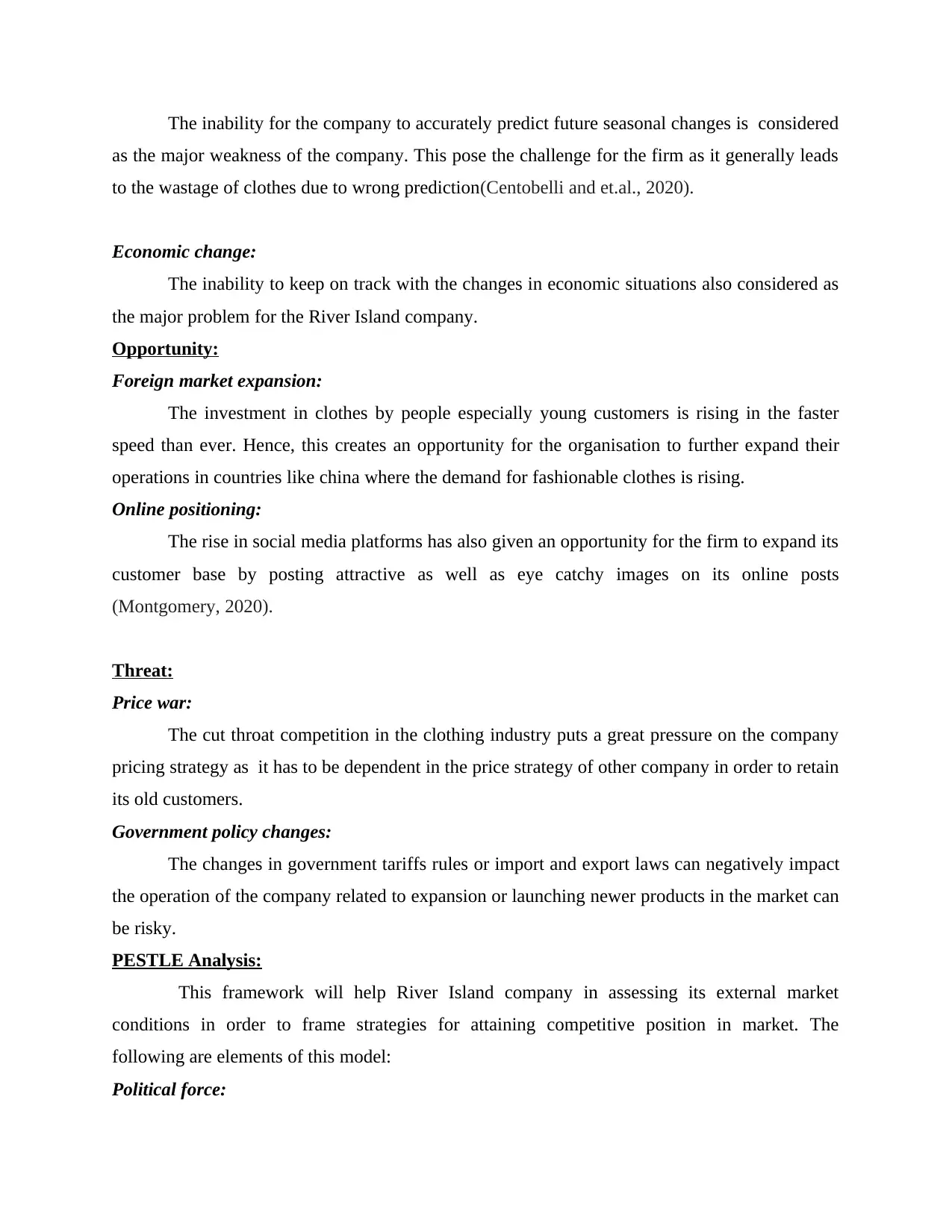
The inability for the company to accurately predict future seasonal changes is considered
as the major weakness of the company. This pose the challenge for the firm as it generally leads
to the wastage of clothes due to wrong prediction(Centobelli and et.al., 2020).
Economic change:
The inability to keep on track with the changes in economic situations also considered as
the major problem for the River Island company.
Opportunity:
Foreign market expansion:
The investment in clothes by people especially young customers is rising in the faster
speed than ever. Hence, this creates an opportunity for the organisation to further expand their
operations in countries like china where the demand for fashionable clothes is rising.
Online positioning:
The rise in social media platforms has also given an opportunity for the firm to expand its
customer base by posting attractive as well as eye catchy images on its online posts
(Montgomery, 2020).
Threat:
Price war:
The cut throat competition in the clothing industry puts a great pressure on the company
pricing strategy as it has to be dependent in the price strategy of other company in order to retain
its old customers.
Government policy changes:
The changes in government tariffs rules or import and export laws can negatively impact
the operation of the company related to expansion or launching newer products in the market can
be risky.
PESTLE Analysis:
This framework will help River Island company in assessing its external market
conditions in order to frame strategies for attaining competitive position in market. The
following are elements of this model:
Political force:
as the major weakness of the company. This pose the challenge for the firm as it generally leads
to the wastage of clothes due to wrong prediction(Centobelli and et.al., 2020).
Economic change:
The inability to keep on track with the changes in economic situations also considered as
the major problem for the River Island company.
Opportunity:
Foreign market expansion:
The investment in clothes by people especially young customers is rising in the faster
speed than ever. Hence, this creates an opportunity for the organisation to further expand their
operations in countries like china where the demand for fashionable clothes is rising.
Online positioning:
The rise in social media platforms has also given an opportunity for the firm to expand its
customer base by posting attractive as well as eye catchy images on its online posts
(Montgomery, 2020).
Threat:
Price war:
The cut throat competition in the clothing industry puts a great pressure on the company
pricing strategy as it has to be dependent in the price strategy of other company in order to retain
its old customers.
Government policy changes:
The changes in government tariffs rules or import and export laws can negatively impact
the operation of the company related to expansion or launching newer products in the market can
be risky.
PESTLE Analysis:
This framework will help River Island company in assessing its external market
conditions in order to frame strategies for attaining competitive position in market. The
following are elements of this model:
Political force:
⊘ This is a preview!⊘
Do you want full access?
Subscribe today to unlock all pages.

Trusted by 1+ million students worldwide
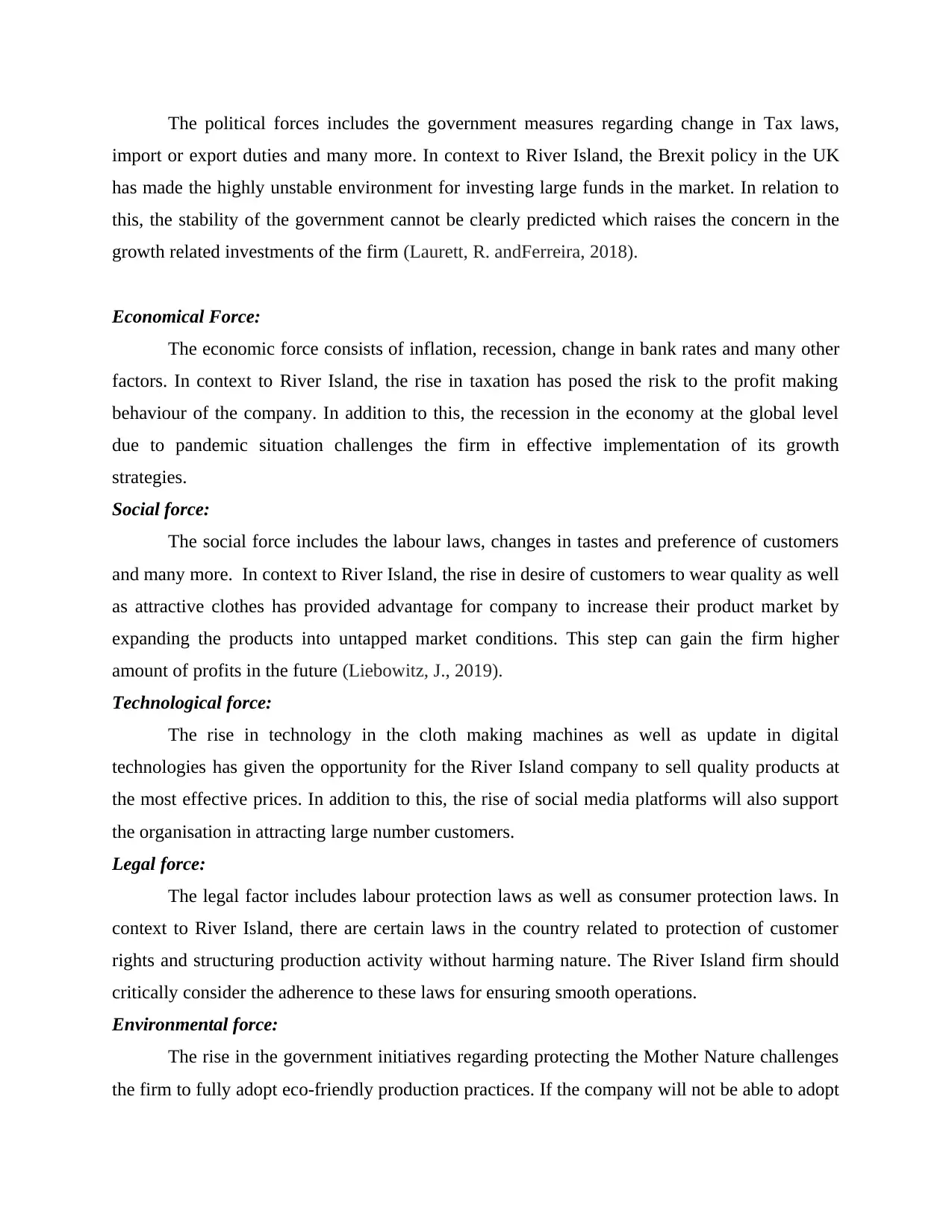
The political forces includes the government measures regarding change in Tax laws,
import or export duties and many more. In context to River Island, the Brexit policy in the UK
has made the highly unstable environment for investing large funds in the market. In relation to
this, the stability of the government cannot be clearly predicted which raises the concern in the
growth related investments of the firm (Laurett, R. andFerreira, 2018).
Economical Force:
The economic force consists of inflation, recession, change in bank rates and many other
factors. In context to River Island, the rise in taxation has posed the risk to the profit making
behaviour of the company. In addition to this, the recession in the economy at the global level
due to pandemic situation challenges the firm in effective implementation of its growth
strategies.
Social force:
The social force includes the labour laws, changes in tastes and preference of customers
and many more. In context to River Island, the rise in desire of customers to wear quality as well
as attractive clothes has provided advantage for company to increase their product market by
expanding the products into untapped market conditions. This step can gain the firm higher
amount of profits in the future (Liebowitz, J., 2019).
Technological force:
The rise in technology in the cloth making machines as well as update in digital
technologies has given the opportunity for the River Island company to sell quality products at
the most effective prices. In addition to this, the rise of social media platforms will also support
the organisation in attracting large number customers.
Legal force:
The legal factor includes labour protection laws as well as consumer protection laws. In
context to River Island, there are certain laws in the country related to protection of customer
rights and structuring production activity without harming nature. The River Island firm should
critically consider the adherence to these laws for ensuring smooth operations.
Environmental force:
The rise in the government initiatives regarding protecting the Mother Nature challenges
the firm to fully adopt eco-friendly production practices. If the company will not be able to adopt
import or export duties and many more. In context to River Island, the Brexit policy in the UK
has made the highly unstable environment for investing large funds in the market. In relation to
this, the stability of the government cannot be clearly predicted which raises the concern in the
growth related investments of the firm (Laurett, R. andFerreira, 2018).
Economical Force:
The economic force consists of inflation, recession, change in bank rates and many other
factors. In context to River Island, the rise in taxation has posed the risk to the profit making
behaviour of the company. In addition to this, the recession in the economy at the global level
due to pandemic situation challenges the firm in effective implementation of its growth
strategies.
Social force:
The social force includes the labour laws, changes in tastes and preference of customers
and many more. In context to River Island, the rise in desire of customers to wear quality as well
as attractive clothes has provided advantage for company to increase their product market by
expanding the products into untapped market conditions. This step can gain the firm higher
amount of profits in the future (Liebowitz, J., 2019).
Technological force:
The rise in technology in the cloth making machines as well as update in digital
technologies has given the opportunity for the River Island company to sell quality products at
the most effective prices. In addition to this, the rise of social media platforms will also support
the organisation in attracting large number customers.
Legal force:
The legal factor includes labour protection laws as well as consumer protection laws. In
context to River Island, there are certain laws in the country related to protection of customer
rights and structuring production activity without harming nature. The River Island firm should
critically consider the adherence to these laws for ensuring smooth operations.
Environmental force:
The rise in the government initiatives regarding protecting the Mother Nature challenges
the firm to fully adopt eco-friendly production practices. If the company will not be able to adopt
Paraphrase This Document
Need a fresh take? Get an instant paraphrase of this document with our AI Paraphraser
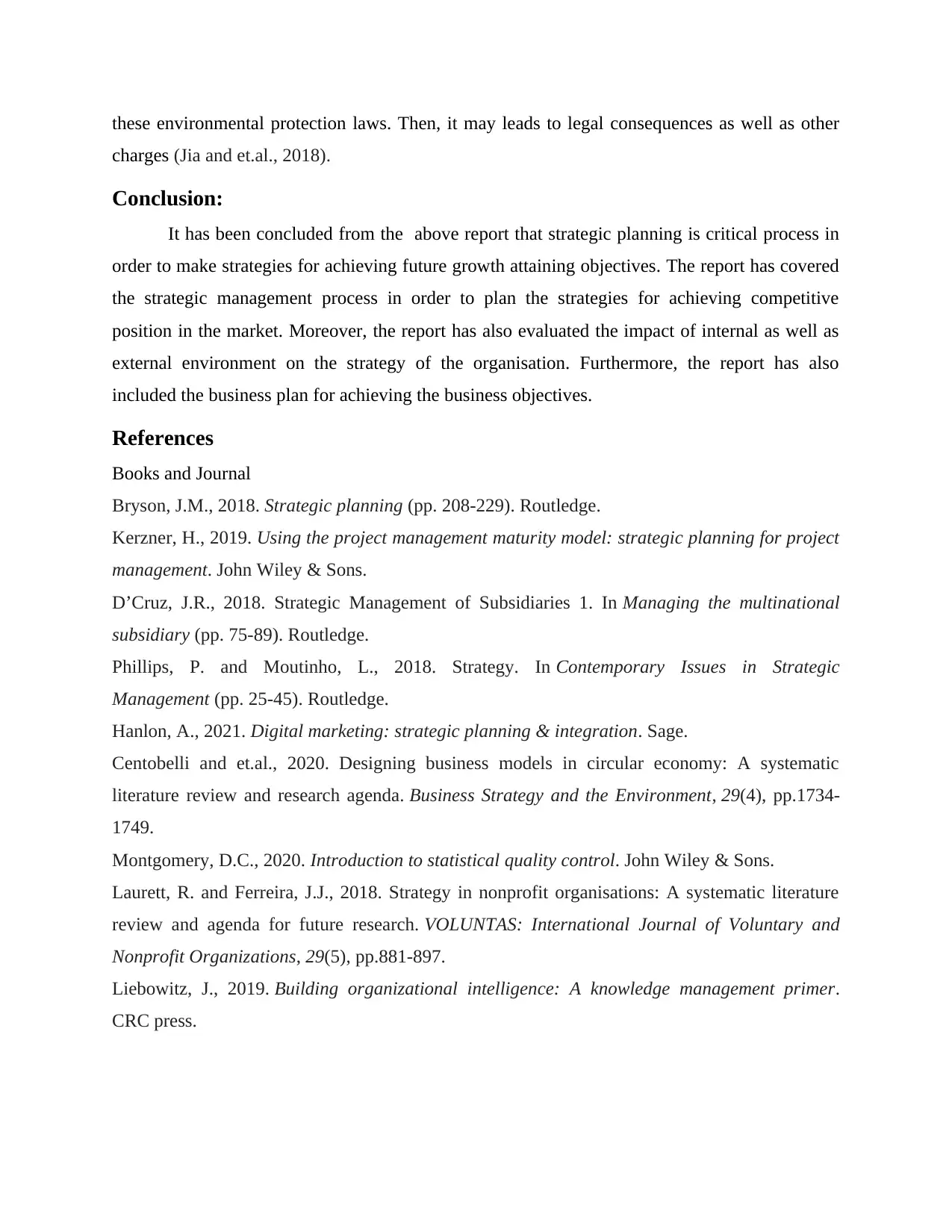
these environmental protection laws. Then, it may leads to legal consequences as well as other
charges (Jia and et.al., 2018).
Conclusion:
It has been concluded from the above report that strategic planning is critical process in
order to make strategies for achieving future growth attaining objectives. The report has covered
the strategic management process in order to plan the strategies for achieving competitive
position in the market. Moreover, the report has also evaluated the impact of internal as well as
external environment on the strategy of the organisation. Furthermore, the report has also
included the business plan for achieving the business objectives.
References
Books and Journal
Bryson, J.M., 2018. Strategic planning (pp. 208-229). Routledge.
Kerzner, H., 2019. Using the project management maturity model: strategic planning for project
management. John Wiley & Sons.
D’Cruz, J.R., 2018. Strategic Management of Subsidiaries 1. In Managing the multinational
subsidiary (pp. 75-89). Routledge.
Phillips, P. and Moutinho, L., 2018. Strategy. In Contemporary Issues in Strategic
Management (pp. 25-45). Routledge.
Hanlon, A., 2021. Digital marketing: strategic planning & integration. Sage.
Centobelli and et.al., 2020. Designing business models in circular economy: A systematic
literature review and research agenda. Business Strategy and the Environment, 29(4), pp.1734-
1749.
Montgomery, D.C., 2020. Introduction to statistical quality control. John Wiley & Sons.
Laurett, R. and Ferreira, J.J., 2018. Strategy in nonprofit organisations: A systematic literature
review and agenda for future research. VOLUNTAS: International Journal of Voluntary and
Nonprofit Organizations, 29(5), pp.881-897.
Liebowitz, J., 2019. Building organizational intelligence: A knowledge management primer.
CRC press.
charges (Jia and et.al., 2018).
Conclusion:
It has been concluded from the above report that strategic planning is critical process in
order to make strategies for achieving future growth attaining objectives. The report has covered
the strategic management process in order to plan the strategies for achieving competitive
position in the market. Moreover, the report has also evaluated the impact of internal as well as
external environment on the strategy of the organisation. Furthermore, the report has also
included the business plan for achieving the business objectives.
References
Books and Journal
Bryson, J.M., 2018. Strategic planning (pp. 208-229). Routledge.
Kerzner, H., 2019. Using the project management maturity model: strategic planning for project
management. John Wiley & Sons.
D’Cruz, J.R., 2018. Strategic Management of Subsidiaries 1. In Managing the multinational
subsidiary (pp. 75-89). Routledge.
Phillips, P. and Moutinho, L., 2018. Strategy. In Contemporary Issues in Strategic
Management (pp. 25-45). Routledge.
Hanlon, A., 2021. Digital marketing: strategic planning & integration. Sage.
Centobelli and et.al., 2020. Designing business models in circular economy: A systematic
literature review and research agenda. Business Strategy and the Environment, 29(4), pp.1734-
1749.
Montgomery, D.C., 2020. Introduction to statistical quality control. John Wiley & Sons.
Laurett, R. and Ferreira, J.J., 2018. Strategy in nonprofit organisations: A systematic literature
review and agenda for future research. VOLUNTAS: International Journal of Voluntary and
Nonprofit Organizations, 29(5), pp.881-897.
Liebowitz, J., 2019. Building organizational intelligence: A knowledge management primer.
CRC press.
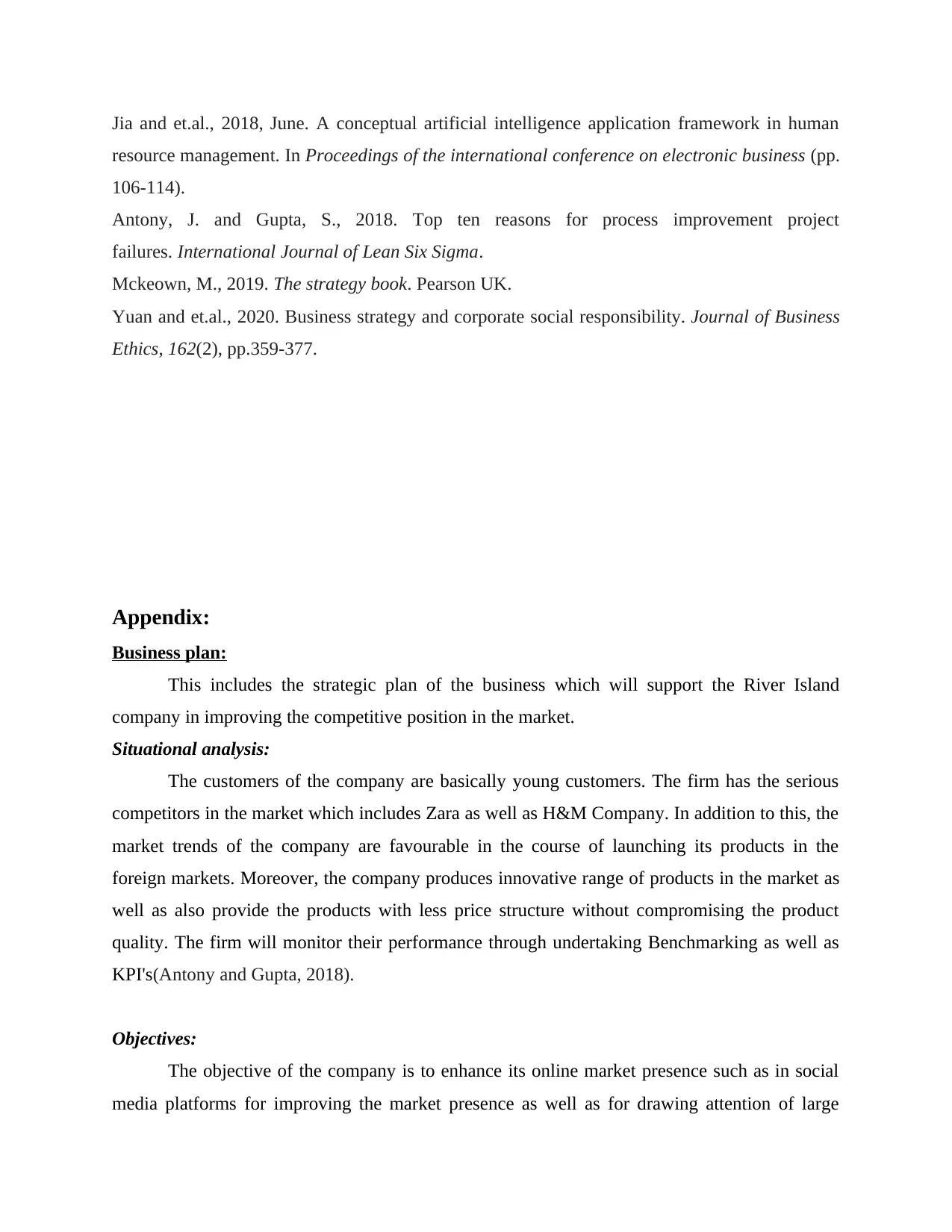
Jia and et.al., 2018, June. A conceptual artificial intelligence application framework in human
resource management. In Proceedings of the international conference on electronic business (pp.
106-114).
Antony, J. and Gupta, S., 2018. Top ten reasons for process improvement project
failures. International Journal of Lean Six Sigma.
Mckeown, M., 2019. The strategy book. Pearson UK.
Yuan and et.al., 2020. Business strategy and corporate social responsibility. Journal of Business
Ethics, 162(2), pp.359-377.
Appendix:
Business plan:
This includes the strategic plan of the business which will support the River Island
company in improving the competitive position in the market.
Situational analysis:
The customers of the company are basically young customers. The firm has the serious
competitors in the market which includes Zara as well as H&M Company. In addition to this, the
market trends of the company are favourable in the course of launching its products in the
foreign markets. Moreover, the company produces innovative range of products in the market as
well as also provide the products with less price structure without compromising the product
quality. The firm will monitor their performance through undertaking Benchmarking as well as
KPI's(Antony and Gupta, 2018).
Objectives:
The objective of the company is to enhance its online market presence such as in social
media platforms for improving the market presence as well as for drawing attention of large
resource management. In Proceedings of the international conference on electronic business (pp.
106-114).
Antony, J. and Gupta, S., 2018. Top ten reasons for process improvement project
failures. International Journal of Lean Six Sigma.
Mckeown, M., 2019. The strategy book. Pearson UK.
Yuan and et.al., 2020. Business strategy and corporate social responsibility. Journal of Business
Ethics, 162(2), pp.359-377.
Appendix:
Business plan:
This includes the strategic plan of the business which will support the River Island
company in improving the competitive position in the market.
Situational analysis:
The customers of the company are basically young customers. The firm has the serious
competitors in the market which includes Zara as well as H&M Company. In addition to this, the
market trends of the company are favourable in the course of launching its products in the
foreign markets. Moreover, the company produces innovative range of products in the market as
well as also provide the products with less price structure without compromising the product
quality. The firm will monitor their performance through undertaking Benchmarking as well as
KPI's(Antony and Gupta, 2018).
Objectives:
The objective of the company is to enhance its online market presence such as in social
media platforms for improving the market presence as well as for drawing attention of large
⊘ This is a preview!⊘
Do you want full access?
Subscribe today to unlock all pages.

Trusted by 1+ million students worldwide
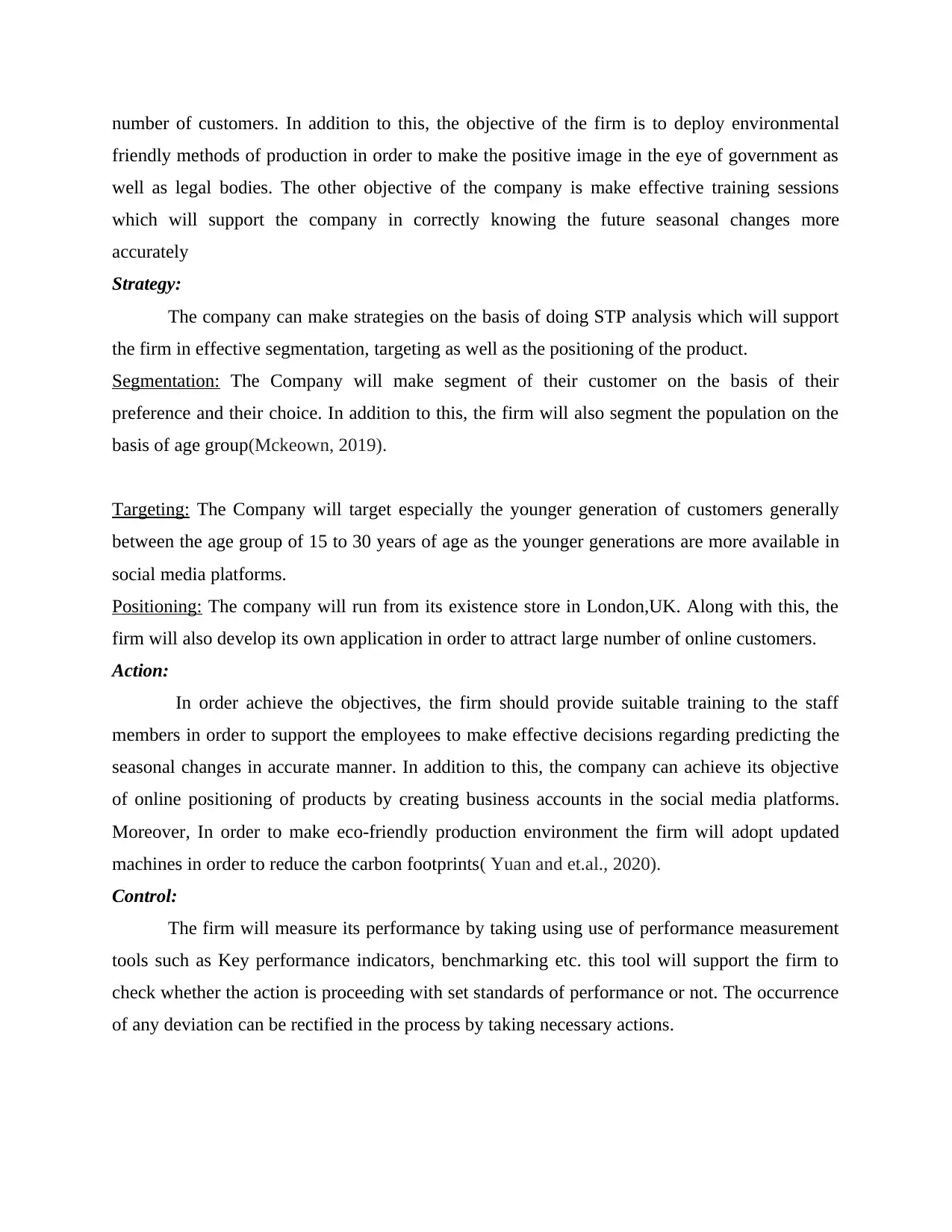
number of customers. In addition to this, the objective of the firm is to deploy environmental
friendly methods of production in order to make the positive image in the eye of government as
well as legal bodies. The other objective of the company is make effective training sessions
which will support the company in correctly knowing the future seasonal changes more
accurately
Strategy:
The company can make strategies on the basis of doing STP analysis which will support
the firm in effective segmentation, targeting as well as the positioning of the product.
Segmentation: The Company will make segment of their customer on the basis of their
preference and their choice. In addition to this, the firm will also segment the population on the
basis of age group(Mckeown, 2019).
Targeting: The Company will target especially the younger generation of customers generally
between the age group of 15 to 30 years of age as the younger generations are more available in
social media platforms.
Positioning: The company will run from its existence store in London,UK. Along with this, the
firm will also develop its own application in order to attract large number of online customers.
Action:
In order achieve the objectives, the firm should provide suitable training to the staff
members in order to support the employees to make effective decisions regarding predicting the
seasonal changes in accurate manner. In addition to this, the company can achieve its objective
of online positioning of products by creating business accounts in the social media platforms.
Moreover, In order to make eco-friendly production environment the firm will adopt updated
machines in order to reduce the carbon footprints( Yuan and et.al., 2020).
Control:
The firm will measure its performance by taking using use of performance measurement
tools such as Key performance indicators, benchmarking etc. this tool will support the firm to
check whether the action is proceeding with set standards of performance or not. The occurrence
of any deviation can be rectified in the process by taking necessary actions.
friendly methods of production in order to make the positive image in the eye of government as
well as legal bodies. The other objective of the company is make effective training sessions
which will support the company in correctly knowing the future seasonal changes more
accurately
Strategy:
The company can make strategies on the basis of doing STP analysis which will support
the firm in effective segmentation, targeting as well as the positioning of the product.
Segmentation: The Company will make segment of their customer on the basis of their
preference and their choice. In addition to this, the firm will also segment the population on the
basis of age group(Mckeown, 2019).
Targeting: The Company will target especially the younger generation of customers generally
between the age group of 15 to 30 years of age as the younger generations are more available in
social media platforms.
Positioning: The company will run from its existence store in London,UK. Along with this, the
firm will also develop its own application in order to attract large number of online customers.
Action:
In order achieve the objectives, the firm should provide suitable training to the staff
members in order to support the employees to make effective decisions regarding predicting the
seasonal changes in accurate manner. In addition to this, the company can achieve its objective
of online positioning of products by creating business accounts in the social media platforms.
Moreover, In order to make eco-friendly production environment the firm will adopt updated
machines in order to reduce the carbon footprints( Yuan and et.al., 2020).
Control:
The firm will measure its performance by taking using use of performance measurement
tools such as Key performance indicators, benchmarking etc. this tool will support the firm to
check whether the action is proceeding with set standards of performance or not. The occurrence
of any deviation can be rectified in the process by taking necessary actions.
Paraphrase This Document
Need a fresh take? Get an instant paraphrase of this document with our AI Paraphraser


⊘ This is a preview!⊘
Do you want full access?
Subscribe today to unlock all pages.

Trusted by 1+ million students worldwide
1 out of 13
Related Documents
Your All-in-One AI-Powered Toolkit for Academic Success.
+13062052269
info@desklib.com
Available 24*7 on WhatsApp / Email
![[object Object]](/_next/static/media/star-bottom.7253800d.svg)
Unlock your academic potential
Copyright © 2020–2025 A2Z Services. All Rights Reserved. Developed and managed by ZUCOL.





